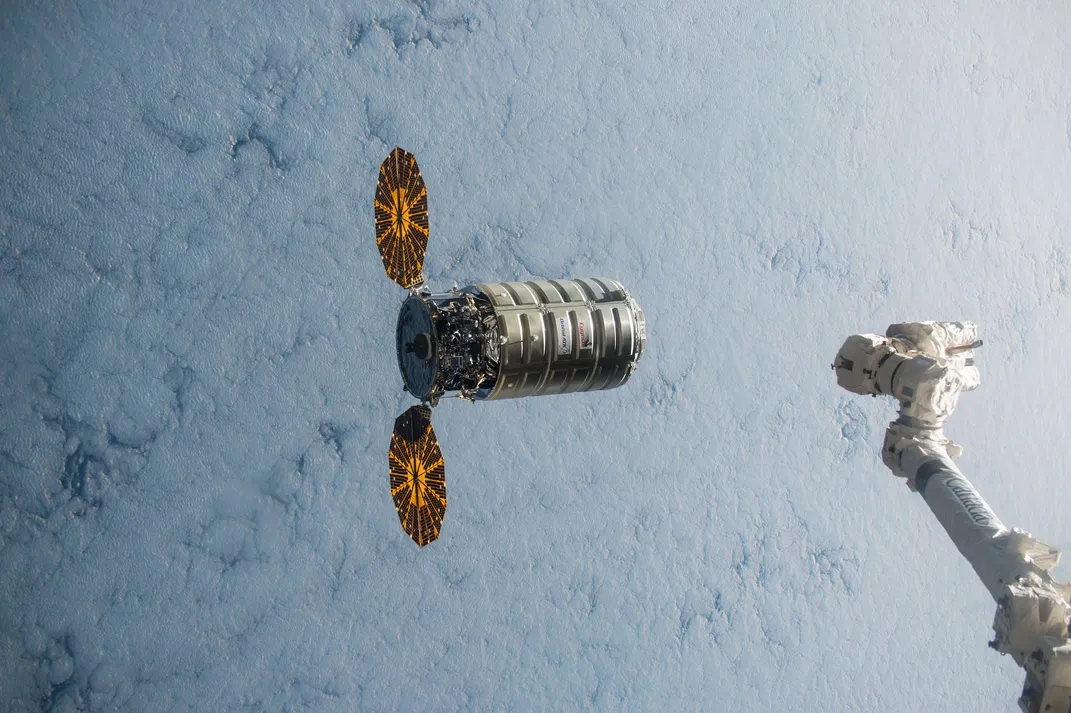NASA Plans to Light a Fire Inside a Spacecraft, Then Watch What Happens
Relax, it’s being done for science.
:focal(2613x1674:2614x1675)/https://tf-cmsv2-smithsonianmag-media.s3.amazonaws.com/filer/b8/ac/b8ac22cd-6340-41a2-ac51-2c763fbe0454/iss038e049159.jpg)
For the past couple of weeks, on and off, astronaut Tim Kopra has been playing with fire on the International Space Station—part of an experiment called Burning and Suppression of Solids—Milliken (BASS-M), to test how flame-retardant cotton fabrics burn in microgravity.
Why? Because fire behaves differently in space than it does on Earth. In normal gravity, hot gas rises, drawing in cool, fresh air at the base of the flame. That’s what gives flames their familiar teardrop shape. In microgravity, hot gas doesn’t rise, so flames tend to be wider, shorter, and rounder than on Earth. As a result, flames in space radiate heat differently than they do on Earth, which in turn affects how fires spread. That means materials may be more or less flammable in orbit than they are on Earth, even with the same mix of atmospheric gases.
When it comes to flammability tests, size matters. On Earth, NASA uses 5 cm by 25 cm samples of flammable material. But pieces that big aren’t allowed on the station (with some exceptions when there is no practical alternative, such as the crew’s clothing). So experiments like BASS-M (which follows up on earlier BASS combustion experiments carried out on the station from 2011 to 2013) make do with small samples, about one centimeter by three centimeters.
“The problem with small samples is that a lot of aspects of the fire don’t scale linearly, so you can’t look at a tiny, one-centimeter fire and extrapolate that to one that’s a foot wide or something,” said David Urban, a combustion researcher at NASA’s Glenn Research Center.
Scientists would like to know exactly how large-scale fires would grow and spread in microgravity, but it’s too dangerous to conduct that kind of experiment on a spacecraft with astronauts on board. Instead, safety engineers have to rely mostly on models based on how flames spread in Earth’s gravity, and on a few small combustion experiments in space.
Sometimes you just need a bigger fire. So Urban and co-investigator Gary Ruff designed the Spacecraft Fire Experiment (Saffire), a series of six tests that will ignite and study contained fires aboard returning Cygnus cargo ships (the next of which is scheduled to depart the station on Friday). When they leave the ISS, the Cygnus ships contain only trash, and they burn up during re-entry. They’re expendable, which makes them the perfect place to set a fire.
When the next Cygnus (number OA-6) launches on March 22 [Note: Launch date updated from March 20], it will carry, along with new supplies for the station, the experimental hardware for Saffire-I. A metal box with fans at either end houses a 0.4- by 0.94-meter sheet of SIBAL cloth, a blend of 75 percent cotton and 25 percent fiberglass. Cotton is used in crew clothing, towels, and other cloth items aboard the station, and the fiberglass blend keeps the sample material from ripping and tearing as it burns. The fans will regulate airflow into and out of the fire.
After Cygnus detaches from the station in mid-May, a ground team will turn on power to the Saffire hardware and activate an electronic igniter at one corner of the SIBAL fabric. As the sample burns, instruments will measure temperature, pressure, and concentrations of oxygen and carbon dioxide near the fire. Video cameras will record the shape, growth, and spread of the flames.

The fire should consume the sample fabric and burn itself out in about two hours, but Cygnus will spend another four days in orbit, downlinking to stations on Earth so the researchers can retrieve Saffire’s experimental data before the resupply ship re-enters Earth’s atmosphere and breaks up over the Pacific.
Saffire-II is scheduled to launch on OA-7 in October. With nine smaller samples—including more SIBAL cloth, Nomex, and plexiglass—it will replicate the flammability tests that NASA conducts on Earth. That should help researchers determine how well those tests predict the materials’ flammability in microgravity.
In 2017, Saffire-III will repeat Saffire-I’s large-scale fire, but this time with a stronger airflow. Since airflow is the main factor that influences the size of flames in space, researchers expect to see larger flames in Saffire-III.
The recent BASS-M experiments have helped lay the groundwork for these first three fire experiments, just as they will prepare the way for Saffire-IV through Saffire-VI. These later missions will study how heat and pressure from large fires could affect the rest of the spacecraft cabin, and will give NASA a chance to demonstrate fire suppression technologies that it has spent the last several years developing.

